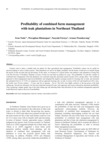Profitability of combined farm management with teak plantations in Northeast Thailand
JIRCAS Working Report
| ISSN | 1341710X |
|---|---|
| 書誌レコードID(総合目録DB) | AA11159468 |

本文フルテキスト
jircas_working_report74-_82-89.pdf653.53 KB
Farmers want to select a suitable land use pattern for their agricultural land management. Profitability criteria can be useful for decision-making to select a better practice. Teak plantations are said to be highly profitable, but the farmer would have no benefit during the period of time up until teak log harvesting. In this study, we focused on a typical farmer who planted a teak plantation in Nong Bua Lam Phu Province of Northeast Thailand, in terms of land size and land use pattern for crops. The profitability of cash flow models of combined farm management with teak plantation was examined using the equivalent annual income (EAI), among others. The combined approach to farm management improved profitability and mitigated the negative earnings caused by focusing only on teak, and increased the estimated EAIs by 19–315% in comparison with an approach focusing only on teak. In terms of the EAI and benefit/cost (B/C) ratio, the results were 20-year rotation > 15-year, and 4x4 m spacing > 2x4 m. The EAIs were highly sensitive to the log prices at the final cutting age. Second rice allocation was the most important among all crops, and sugarcane and cassava allocations decreased profitability. Thus, producing a higher quality logs at the final cutting age and selecting better land allocation for the combined management approach could effectively improve the level of profitability.
| 刊行年月日 | |
|---|---|
| 作成者 | Iwao Noda Woraphun Himmapan Naoyuki Furuya Arunee Pusudsavang |
| 著者キーワード | teak forest management land use farmers discounted cash flow |
| 巻 | 74 |
| 開始ページ | 82 |
| 終了ページ | 89 |
| 関連するリソース | 部分である : JIRCAS Working Report no.74 |
| 言語 | eng |
関連する刊行物
部分である
